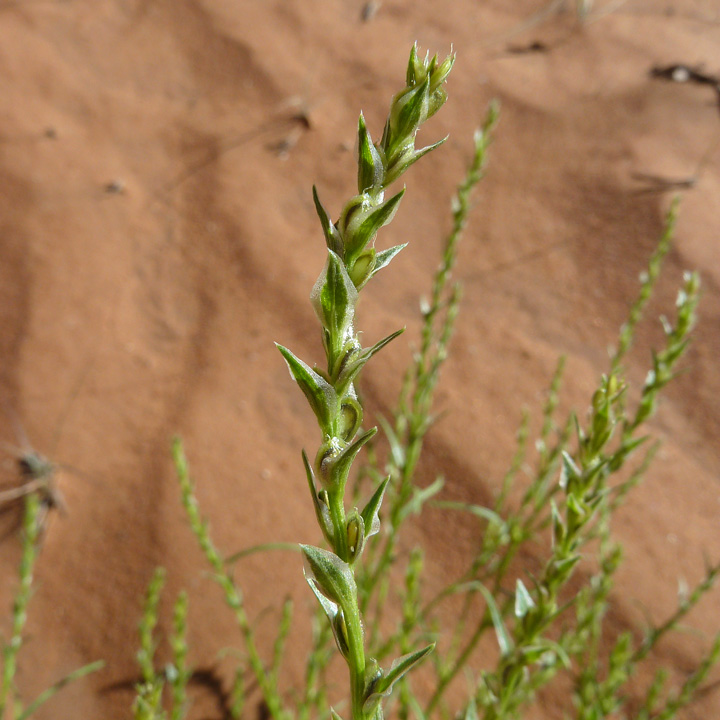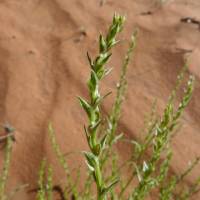Herbs, annual, with dendroid (branched), sometimes almost stellate hairs, occasionally glabrous, or becoming glabrous at maturity. Stems erect or ascending, rarely prostrate, branched (rarely simple), not jointed, not armed, not fleshy. Leaves alternate, sessile; blade [obovate-elliptic, elliptic], lanceolate, linear-lanceolate, linear, or filiform, flat or convolute at maturity, base truncate, margins entire [indistinctly undulate], apex acute. Inflorescences terminal spikes; flowers solitary in axils of ovate, lanceolate, or linear leaflike bracts (also in axils of middle and lower leaves and branches in C. ochotense and occasionally in some other species). Flowers bisexual; perianth segments absent or 1(-3), scalelike; stamens 1-3(-5); ovary superior; stigmas and styles 2. Fruiting structures: style bases at maturity forming characteristic bifid rostrum ('beak') at apex of achenes [concealed by wing in some species], achenes largely exposed, vertical, sessile, convex to almost plane abaxially, plane, ± concave adaxially, lenticular, ovate, obovate, elliptic, or orbiculate [elongate], margins winged or wingless, apex acute, glabrous and shiny, or maculate and/or slightly verrucose; wing (if present) with entire, undulate, or minutely erose-denticulate margins (in some species emarginate at apex, or long-adnate to style bases); pericarp strongly accrescent to seed or small portions not accrescent, forming small whitish bladders ('warts'). Seeds vertical; embryo horseshoe-shaped or almost circular; perisperm abundant. x = 9.
Mature fruits are important and usually necessary for reliable identification of Corispermum. Serial herbarium material showing variability is also desirable. The wing of a fruit should be observed and measured from the abaxial (dorsal) face of a fruit. When observed from the adaxial face, the pale margin marking the position of the hippocrepiform peripheral embryo could be confused for the true wing.
For a long time representatives of this genus were believed to be recently introduced to North America from Europe. In the treatment by N. J. Maihle and W. H. Blackwell (1978) only three species were reported for North America: Corispermum hyssopifolium Linnaeus, C. nitidum Kitaibel ex Schultes, and C. orientale Lamarck (all Eurasian). However, it is now clear from both recent taxonomic studies and fossil evidence that Corispermum was present in North America at least 38,000 years b.p. in Alaska and the Yukon, 11,000-14,000 years b.p. in Arizona and Utah, and ca. 4000 years b.p. in New Mexico (for details see C. O. Rosendahl 1948; J. L. Betancourt et al. 1984; J. V. Matthews Jr. 1982; S. B. Young 1982; S. L. Mosyakin 1995, 1997). Native American species of Corispermum are evidently closely related to eastern Asian (especially Siberian) ones, but not to native European taxa.
Although specific limits between related taxa in Corispermum are uncertain, a rather narrow species concept is accepted in the present treatment. The author is well aware of possible shortcomings and inconveniences of that approach and agrees with the opinion expressed by W. S. Judd and I. K. Ferguson (1999, p. 406): 'It seems clear both that an extremely broad treatment of C. hyssopifolium is not justified, especially since the genus is indigenous in North America, and that a typological approach leading to the recognition of numerous arbitrarily separated microspecies is not useful.' My first intention was to make the treatment consistent with the prevailing Eurasian narrow species concept for the genus applied by M. M. Iljin (1929, 1936), P. Aellen (1961, 1964), M. V. Klokov (1960), M. Kitagawa (1935), Tsien C. P. and Ma C. G. (1979), and others. I also wanted to emphasize the unusual diversity of the native Corispermum taxa in North America. Unfortunately, virtually no experimental taxonomic or field ecological research has been done on taxa of the genus in Asia and North America, and I had no other choice but to rely almost exclusively on herbarium taxonomy and experience with Eurasian taxa. It remains the task of further studies to reveal the precise natural boundaries between North American species of Corispermum and their phylogenetic links to Eurasian taxa.
Because of common misidentifications in the past and the limited scope of the current treatment, which was based almost exclusively on herbarium specim
Fls perfect; cal minute, scarious, of a single adaxial sep, or sometimes also with 2 smaller abaxial sep; stamens 1-3, exsert; ovary compressed, erect, exceeding the cal; styles 2, short; fr indurate, indehiscent, plano-convex, erect, angled or narrowly margined or winged; pericarp closely adherent to the erect seed; embryo annular; much-branched herbs with linear or subulate lvs, the fls solitary in the axils of the bracts, forming a continuous or interrupted terminal spike. Late summer, fall. 50, Eurasia.
Gleason, Henry A. & Cronquist, Arthur J. 1991. Manual of vascular plants of northeastern United States and adjacent Canada. lxxv + 910 pp.
©The New York Botanical Garden. All rights reserved. Used by permission.





